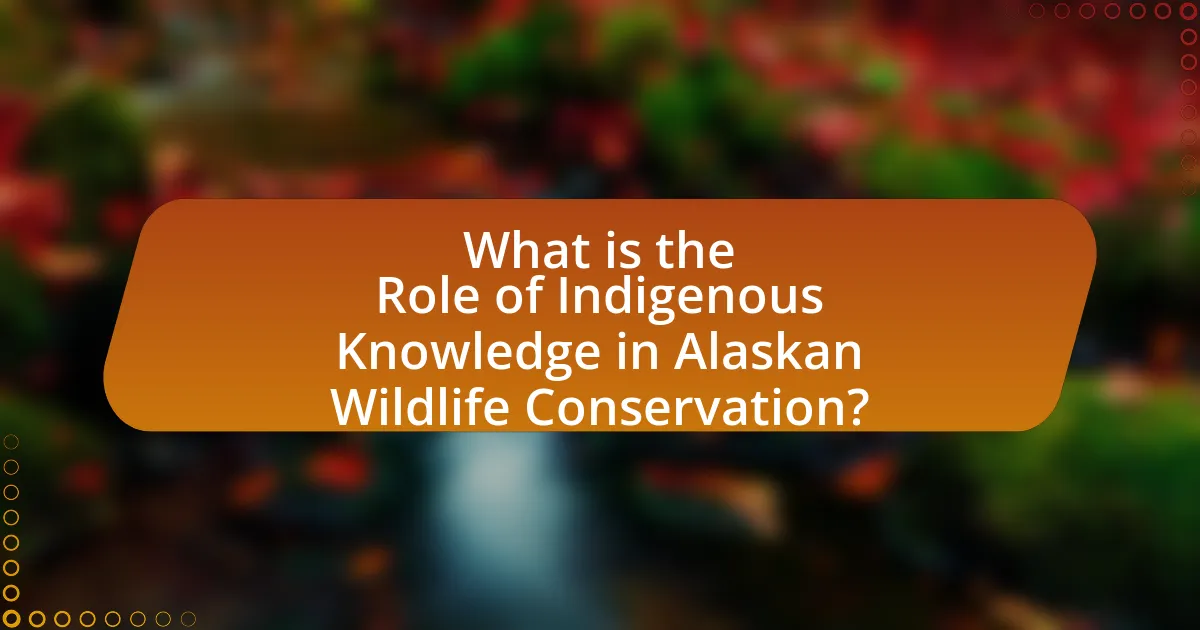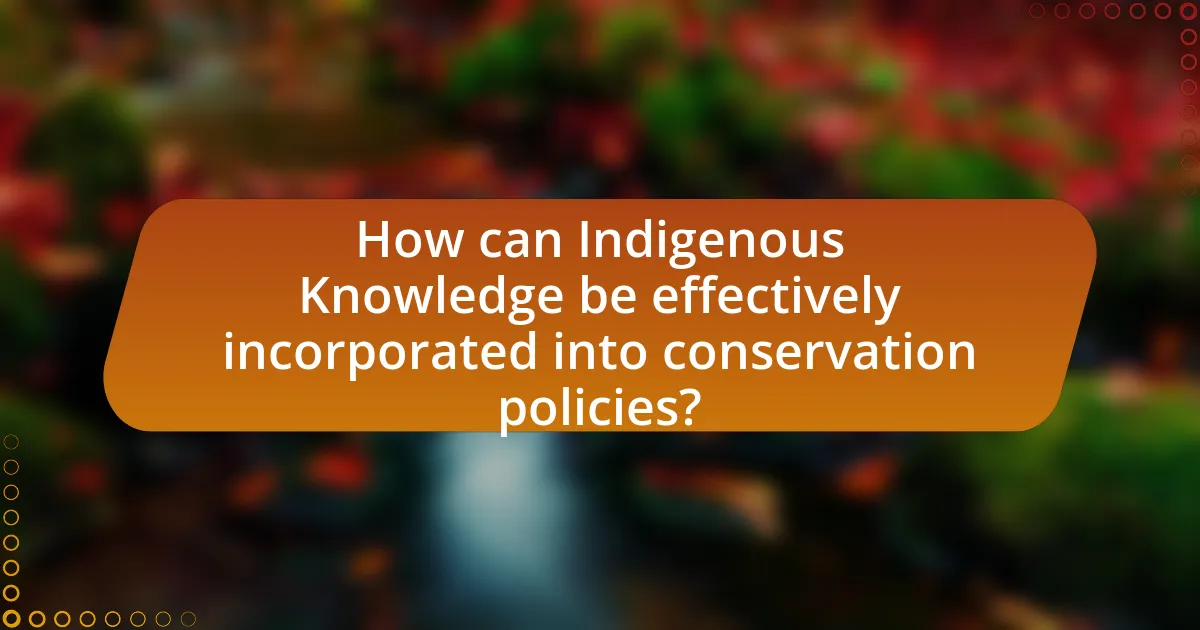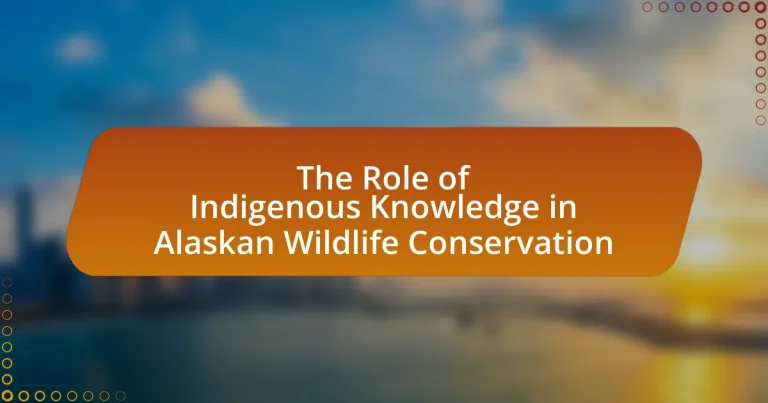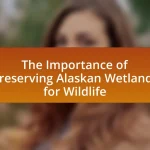The article examines the critical role of Indigenous Knowledge in Alaskan wildlife conservation, highlighting its integration with traditional ecological knowledge (TEK) to enhance biodiversity and ecosystem health. It discusses how Indigenous practices inform sustainable resource management, species behavior, and habitat preservation, contributing to effective conservation strategies. The article also addresses the challenges faced by Indigenous communities, such as marginalization and climate change, while emphasizing the importance of collaboration between Indigenous peoples and conservationists to improve wildlife management outcomes. Additionally, it outlines best practices for incorporating Indigenous perspectives into conservation policies and the significance of education in promoting awareness of traditional ecological knowledge.

What is the Role of Indigenous Knowledge in Alaskan Wildlife Conservation?
Indigenous knowledge plays a crucial role in Alaskan wildlife conservation by providing insights into sustainable practices and ecological understanding developed over generations. This knowledge encompasses traditional ecological knowledge (TEK), which includes species behavior, habitat management, and seasonal patterns that are vital for effective conservation strategies. For instance, Indigenous communities have historically managed caribou migrations and fish populations through practices that align with natural cycles, demonstrating a deep understanding of local ecosystems. Research indicates that integrating Indigenous knowledge with scientific approaches enhances biodiversity conservation efforts, as seen in collaborative projects that have successfully restored habitats and improved wildlife populations in Alaska.
How does Indigenous Knowledge contribute to wildlife conservation efforts in Alaska?
Indigenous Knowledge significantly contributes to wildlife conservation efforts in Alaska by integrating traditional ecological practices with contemporary conservation strategies. This knowledge encompasses a deep understanding of local ecosystems, species behaviors, and sustainable resource management, which has been developed over thousands of years. For instance, Indigenous communities utilize seasonal migration patterns and breeding cycles of wildlife to inform hunting practices, ensuring that populations remain stable and ecosystems are balanced. Research indicates that Indigenous-led conservation initiatives, such as the co-management of marine resources, have led to improved biodiversity outcomes and resilience against climate change impacts. This synergy between Indigenous Knowledge and scientific approaches enhances the effectiveness of conservation efforts in Alaska.
What are the key principles of Indigenous Knowledge relevant to wildlife conservation?
The key principles of Indigenous Knowledge relevant to wildlife conservation include a deep understanding of local ecosystems, sustainable resource management, and the integration of cultural practices with environmental stewardship. Indigenous communities possess extensive knowledge about species behavior, migration patterns, and habitat requirements, which has been developed over generations through direct interaction with the land. This knowledge emphasizes the importance of maintaining biodiversity and ecological balance, as seen in practices such as seasonal hunting and fishing that align with animal life cycles. Furthermore, Indigenous Knowledge often incorporates spiritual beliefs and cultural values that foster a sense of responsibility towards the environment, reinforcing conservation efforts. Studies have shown that integrating Indigenous Knowledge with scientific approaches can enhance conservation outcomes, as evidenced by successful co-management initiatives in Alaska that have led to improved wildlife populations and habitat preservation.
How is Indigenous Knowledge integrated into modern conservation practices?
Indigenous Knowledge is integrated into modern conservation practices through collaborative management approaches that incorporate traditional ecological knowledge alongside scientific methods. This integration is evident in Alaskan wildlife conservation, where Indigenous communities actively participate in decision-making processes, ensuring that their understanding of local ecosystems informs conservation strategies. For instance, the Alaska Native Claims Settlement Act of 1971 established a framework for Indigenous involvement in land management, allowing for the incorporation of traditional practices in wildlife management, such as sustainable hunting and fishing techniques that have been passed down through generations. This collaboration has been shown to enhance biodiversity conservation outcomes, as evidenced by studies indicating that areas managed with Indigenous input often exhibit healthier ecosystems and more resilient wildlife populations.
Why is Indigenous Knowledge important for understanding Alaskan ecosystems?
Indigenous Knowledge is crucial for understanding Alaskan ecosystems because it encompasses centuries of observations and interactions with the environment, providing insights into species behavior, ecological relationships, and climate patterns. This knowledge is rooted in the lived experiences of Indigenous peoples, who have developed sustainable practices that reflect a deep understanding of local biodiversity. For example, Indigenous practices in resource management, such as seasonal hunting and fishing, are informed by traditional ecological knowledge that recognizes the importance of maintaining balance within ecosystems. Studies have shown that integrating Indigenous Knowledge with scientific approaches can enhance conservation efforts, as seen in collaborative projects that aim to protect habitats and species in Alaska.
What unique insights does Indigenous Knowledge provide about local wildlife?
Indigenous Knowledge provides unique insights into local wildlife by emphasizing the interconnectedness of species and their habitats, which is informed by centuries of observation and experience. This knowledge includes specific information about animal behavior, migration patterns, and seasonal changes that are critical for effective conservation efforts. For instance, Indigenous communities in Alaska have documented the traditional ecological knowledge of caribou migration routes, which has been validated by scientific studies showing that these routes are essential for the species’ survival. Additionally, Indigenous practices often promote sustainable harvesting methods that ensure the long-term health of wildlife populations, reflecting a deep understanding of ecological balance.
How does Indigenous Knowledge enhance biodiversity conservation strategies?
Indigenous Knowledge enhances biodiversity conservation strategies by integrating traditional ecological practices with contemporary conservation methods. This knowledge, accumulated over generations, includes insights into local ecosystems, species behavior, and sustainable resource management. For instance, Indigenous communities in Alaska utilize traditional hunting and fishing practices that align with seasonal changes, promoting species regeneration and habitat preservation. Research indicates that areas managed with Indigenous Knowledge often exhibit higher biodiversity levels compared to those managed solely by conventional methods, as seen in studies highlighting the effectiveness of Indigenous-led conservation initiatives in maintaining ecological balance and resilience.

What challenges does Indigenous Knowledge face in Alaskan Wildlife Conservation?
Indigenous Knowledge in Alaskan Wildlife Conservation faces challenges such as the marginalization of traditional practices, legal barriers, and climate change impacts. Marginalization occurs when Indigenous perspectives are overlooked in favor of Western scientific approaches, leading to a disconnect between local communities and conservation efforts. Legal barriers include restrictions on land use and resource management that limit Indigenous peoples’ ability to apply their knowledge effectively. Additionally, climate change poses significant threats to wildlife and ecosystems, complicating the application of traditional ecological knowledge, as shifting environmental conditions may alter species behavior and habitat availability. These challenges hinder the integration of Indigenous Knowledge into effective wildlife conservation strategies.
How do external factors impact the application of Indigenous Knowledge?
External factors significantly impact the application of Indigenous Knowledge by influencing its recognition, integration, and effectiveness in wildlife conservation efforts. For instance, legal frameworks and policies often dictate how Indigenous Knowledge is utilized in conservation practices; when these frameworks are supportive, such as through co-management agreements, Indigenous perspectives can enhance biodiversity outcomes. Conversely, external pressures like climate change and industrial development can undermine traditional practices, leading to a disconnect between Indigenous communities and their environmental stewardship roles. Research indicates that successful conservation initiatives often arise from collaborative approaches that respect and incorporate Indigenous Knowledge, as seen in the work of the Alaska Native Science Commission, which emphasizes the importance of local ecological knowledge in managing wildlife resources.
What role do climate change and industrial development play in these challenges?
Climate change and industrial development significantly exacerbate challenges in Alaskan wildlife conservation. Climate change alters habitats, disrupts migration patterns, and affects food availability for various species, leading to population declines. For instance, rising temperatures have resulted in the melting of sea ice, which is crucial for species like polar bears and seals. Industrial development, such as oil drilling and mining, further threatens wildlife by introducing pollution, habitat destruction, and increased human-wildlife conflicts. The cumulative impact of these factors jeopardizes the delicate balance of ecosystems, making it increasingly difficult for indigenous communities to rely on traditional knowledge for sustainable wildlife management.
How can Indigenous communities overcome barriers to sharing their knowledge?
Indigenous communities can overcome barriers to sharing their knowledge by fostering collaborative partnerships with academic institutions and government agencies. These partnerships can facilitate the integration of Indigenous knowledge into wildlife conservation efforts, ensuring that traditional practices are respected and utilized. For instance, the collaboration between the Alaska Native Science Commission and various universities has led to successful projects that incorporate Indigenous perspectives in environmental management. This approach not only validates Indigenous knowledge but also enhances the effectiveness of conservation strategies, as evidenced by improved wildlife management outcomes in regions where such collaborations have been established.
What are the implications of disregarding Indigenous Knowledge in conservation?
Disregarding Indigenous Knowledge in conservation leads to ineffective management practices and loss of biodiversity. Indigenous communities possess unique ecological insights developed over generations, which are crucial for understanding local ecosystems. For instance, studies have shown that Indigenous land management practices, such as controlled burns, can enhance habitat quality and promote species diversity. Ignoring these practices can result in ecological imbalances, as evidenced by the decline of certain species in areas where traditional knowledge was overlooked. Furthermore, the exclusion of Indigenous perspectives can foster mistrust and conflict between conservation authorities and local communities, undermining collaborative efforts essential for successful conservation outcomes.
How does this affect wildlife populations and ecosystem health?
Indigenous knowledge significantly enhances wildlife populations and ecosystem health by promoting sustainable practices that align with natural cycles. This knowledge, rooted in centuries of observation and interaction with the environment, informs conservation strategies that maintain biodiversity and ecosystem resilience. For instance, studies have shown that traditional ecological knowledge (TEK) contributes to effective management of species such as caribou and salmon, which are vital for both ecological balance and local communities. Research indicates that areas managed with Indigenous practices often exhibit higher biodiversity and healthier ecosystems compared to those managed solely by conventional methods.
What lessons can be learned from past conservation failures?
Lessons learned from past conservation failures include the importance of integrating local and indigenous knowledge into conservation strategies. Historical examples, such as the decline of the Steller’s sea cow due to overhunting and lack of local input, demonstrate that ignoring traditional ecological knowledge can lead to detrimental outcomes. Additionally, the failure of the U.S. Fish and Wildlife Service to effectively manage the Arctic National Wildlife Refuge highlights the need for collaboration with indigenous communities, who possess valuable insights into sustainable practices. These cases underscore that successful conservation efforts must prioritize community involvement and respect for indigenous practices to avoid repeating past mistakes.

How can Indigenous Knowledge be effectively incorporated into conservation policies?
Indigenous Knowledge can be effectively incorporated into conservation policies by integrating traditional ecological knowledge (TEK) into decision-making processes. This integration involves collaboration between Indigenous communities and conservation agencies, ensuring that local practices and insights inform management strategies. For instance, the U.S. Fish and Wildlife Service has recognized the importance of TEK in managing wildlife populations, as seen in the co-management agreements with Alaska Native tribes that incorporate traditional hunting practices and seasonal migrations into wildlife management plans. Such collaborations enhance the effectiveness of conservation efforts by combining scientific research with Indigenous perspectives, leading to more sustainable outcomes.
What best practices exist for integrating Indigenous Knowledge into wildlife management?
Best practices for integrating Indigenous Knowledge into wildlife management include collaborative partnerships between Indigenous communities and wildlife managers, recognizing and respecting traditional ecological knowledge, and incorporating Indigenous perspectives in decision-making processes. Collaborative partnerships ensure that Indigenous voices are included in management strategies, which enhances the effectiveness of conservation efforts. Recognizing traditional ecological knowledge acknowledges the deep understanding Indigenous peoples have of local ecosystems, which can inform sustainable practices. Incorporating Indigenous perspectives in decision-making processes leads to more culturally relevant and effective wildlife management strategies, as evidenced by successful case studies in Alaska where Indigenous input has improved species management outcomes.
How can collaboration between Indigenous communities and conservationists be fostered?
Collaboration between Indigenous communities and conservationists can be fostered through mutual respect, shared goals, and the integration of Indigenous knowledge into conservation practices. Establishing partnerships that prioritize the traditional ecological knowledge of Indigenous peoples enhances conservation efforts, as evidenced by successful initiatives in Alaska where local insights have led to more effective wildlife management strategies. For instance, the collaboration between the Alaska Native Tribal Health Consortium and conservation organizations has demonstrated that incorporating Indigenous perspectives results in better outcomes for both biodiversity and community well-being.
What frameworks support the inclusion of Indigenous perspectives in policy-making?
Frameworks that support the inclusion of Indigenous perspectives in policy-making include the United Nations Declaration on the Rights of Indigenous Peoples (UNDRIP) and the Indigenous Knowledge Framework. UNDRIP establishes international standards for the rights of Indigenous peoples, emphasizing their right to participate in decision-making processes that affect them. The Indigenous Knowledge Framework promotes the integration of traditional ecological knowledge into environmental management and policy, recognizing the value of Indigenous perspectives in sustainable practices. These frameworks are validated by their adoption in various national and international policies, demonstrating a commitment to incorporating Indigenous voices in governance and conservation efforts.
What role does education play in promoting Indigenous Knowledge for conservation?
Education plays a crucial role in promoting Indigenous Knowledge for conservation by facilitating the transfer of traditional ecological practices and cultural values to both Indigenous and non-Indigenous communities. This educational process enhances understanding of sustainable practices that have been developed over generations, such as the management of local wildlife and ecosystems. For instance, programs that integrate Indigenous perspectives into formal education systems have been shown to improve biodiversity conservation outcomes, as evidenced by the success of initiatives like the Alaska Native Science and Engineering Program, which emphasizes Indigenous methodologies alongside scientific approaches. Such educational frameworks not only empower Indigenous communities but also foster collaborative conservation efforts that respect and utilize traditional knowledge.
How can educational programs raise awareness about Indigenous practices?
Educational programs can raise awareness about Indigenous practices by integrating Indigenous knowledge into curricula and community outreach initiatives. These programs can include workshops, lectures, and field trips that highlight traditional ecological knowledge and its relevance to contemporary wildlife conservation efforts in Alaska. For instance, the incorporation of Indigenous perspectives on sustainable practices can enhance understanding of local ecosystems, as demonstrated by the work of the Alaska Native Science Commission, which emphasizes the importance of Indigenous knowledge in managing wildlife resources effectively.
What resources are available for learning about Indigenous Knowledge in conservation?
Resources available for learning about Indigenous Knowledge in conservation include academic journals, books, online courses, and community workshops. For instance, the journal “Ecological Applications” often publishes research that integrates Indigenous Knowledge with conservation practices. Books such as “Indigenous Knowledge and Education” by K. M. McKinley provide insights into the application of Indigenous perspectives in environmental management. Online platforms like Coursera offer courses on Indigenous environmental stewardship, while local Indigenous organizations frequently conduct workshops that share traditional ecological knowledge. These resources collectively enhance understanding of the vital role Indigenous Knowledge plays in conservation efforts.
What practical steps can be taken to support Indigenous Knowledge in wildlife conservation?
To support Indigenous Knowledge in wildlife conservation, practical steps include integrating Indigenous perspectives into conservation planning and management. This can be achieved by establishing partnerships between Indigenous communities and conservation organizations, ensuring that Indigenous voices are included in decision-making processes. For instance, the Alaska Native Claims Settlement Act has facilitated collaboration between Indigenous groups and federal agencies, allowing for the incorporation of traditional ecological knowledge in wildlife management practices. Additionally, providing funding for Indigenous-led conservation initiatives can empower communities to implement their own strategies based on traditional knowledge, which has been shown to enhance biodiversity conservation outcomes.


